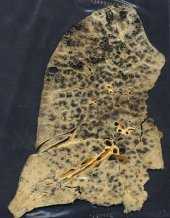Pneumoconioses

Other Resources
Medical and Hazard Statistics Relevant to the Pneumoconioses
Work-Related Lung Disease (eWoRLD) Surveillance System
Presents up-to-date summary tables, graphs, and figures of occupationally-related respiratory disease surveillance data on the pneumoconioses, occupational asthma and other airways diseases, and several other respiratory conditions. Current surveillance statistics and downloadable graphics and data tables are available on specific forms of the pneumoconiosis and their associated hazards:
- Asbestosis
- Coal Workers’ Pneumoconiosis
- Silicosis
- Byssinosis
- Unspecified and Other Pneumoconioses
- All Pneumoconioses
National Occupational Respiratory Mortality System (NORMS)
An interactive query system that can be used to derive statistics on numbers of deaths, death rates, years of life lost, and proportional mortality ratios by age, sex, race, state, industry, and occupation.
Other sources of surveillance information of relevance to the pneumoconioses are:
- The NIOSH 2004 Worker Chartbook
- The NIOSH 2000 Worker Chartbook
- Atlas of Respiratory Disease Mortality, United States: 1982-1993
Other NIOSH Resources
Enhanced Coal Workers’ Health Surveillance Program
In light of the observed onset of advanced pneumoconiosis among younger coal miners, and the apparent regional clustering of rapidly progressive cases, NIOSH, in collaboration with MSHA, has developed, staffed, and implemented the program. Surveys are being completed that include specifically designed standardized health questionnaires, work histories, spirometry testing, radiographic examinations, and collection of other relevant health information, which are gathered in a specially designed mobile examination unit by trained personnel.
Mining Statistics
The Mine Safety and Health Administration routinely collects information on injuries and illnesses related to mining. Because theinformation reliesto some extent on self-reports by workers to their employers these data tend togreatly under-report occupational morbidity. NIOSH has summarized the data here.
State-Based Surveillance for Silicosis
State-based surveillance programs are in a unique position to assist NIOSH in understanding occupational respiratory disease and linking surveillance to practice at the state and local level.
NIOSHTIC-2 Search
NIOSHTIC-2 Search Results on Pneumoconiosis
NIOSHTIC-2 is a searchable bibliographic database of occupational safety and health publications, documents, grant reports, and journal articles supported in whole or in part by NIOSH.
CDC Morbidity and Mortality Weekly Reports
CDC Morbidity and Mortality Weekly Reports
- Coal Workers’ Pneumoconiosis-Related Years of Potential Life Lost Before Age 65 Years — United States, 1968–2006
- Pneumoconiosis Prevalence Among Working Coal Miners Examined in Federal Chest Radiograph Surveillance Programs — United States, 1996-2002
- Changing Patterns of Pneumoconiosis Mortality – United States, 1968-2000
- Silicosis Mortality, Prevention, and Control – United States, 1968-2002
- Advanced Cases of Coal Workers’ Pneumoconiosis – Two Counties, Virginia 2006
- Advanced Pneumoconiosis Among Working Underground Coal Miners — Eastern Kentucky and Southwestern Virginia, 2006
- Silicosis-Related Years of Potential Life Lost Before Age 65 Years — United States, 1968–2005
Other CDC/ATSDR Resources
Asbestos Resources
Asbestos page in the Toxic Substances Portal. With one click, access the best science, the latest research, and the most important information about toxic substances and how they affect our health.
Asbestos Exposure and Your Health
Asbestos mining sites, health effects, types of exposure, exposure responses, medical community information and more.
External Resources
Controlling Respirable Coal Mine Dust in Underground Mines – Workshop Resources
Council of State and Territorial Epidemiologists – Pneumoconiosis Mortality
Council of State and Territorial Epidemiologists – Pneumoconiosis Hospitalizations
ILO International Classification of Radiographs of Pneumoconioses
- Page last reviewed: September 13, 2011
- Page last updated: August 23, 2017
- Content source:
- National Institute for Occupational Safety and Health Respiratory Health Division


 ShareCompartir
ShareCompartir